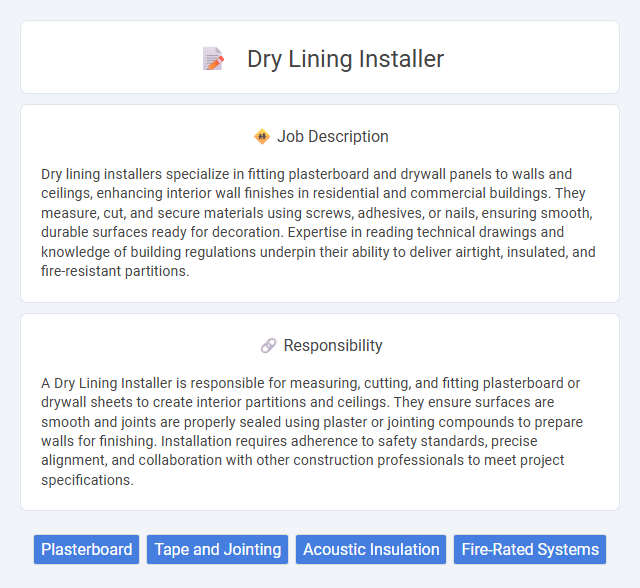
Dry lining installers specialize in fitting plasterboard and drywall panels to walls and ceilings, enhancing interior wall finishes in residential and commercial buildings. They measure, cut, and secure materials using screws, adhesives, or nails, ensuring smooth, durable surfaces ready for decoration. Expertise in reading technical drawings and knowledge of building regulations underpin their ability to deliver airtight, insulated, and fire-resistant partitions.
Individuals with good physical stamina and manual dexterity are likely to be suitable for a dry lining installer job due to the physical demands of handling materials and tools. Candidates who are comfortable working at heights and in confined spaces may have a higher probability of adapting well to the role. Those with limited mobility or chronic health conditions affecting strength might find this job less compatible with their capabilities.
Qualification
A Dry Lining Installer typically requires qualifications such as a City & Guilds Level 2 or 3 in Dry Lining or plastering combined with practical experience in installing plasterboard, partitions, and insulated dry lining systems. Knowledge of health and safety regulations, including COSHH and construction site protocols, is essential to ensure compliance and safe work environments. Competence in reading technical drawings and using tools like taping knives and drilling equipment enhances precision and efficiency in drywall installation projects.
Responsibility
A Dry Lining Installer is responsible for measuring, cutting, and fitting plasterboard or drywall sheets to create interior partitions and ceilings. They ensure surfaces are smooth and joints are properly sealed using plaster or jointing compounds to prepare walls for finishing. Installation requires adherence to safety standards, precise alignment, and collaboration with other construction professionals to meet project specifications.
Benefit
Working as a Dry Lining Installer probably offers a strong potential for consistent employment due to ongoing construction and renovation projects. The job may provide benefits such as skill development, competitive wages, and opportunities for advancement within the construction sector. Health and safety standards could also ensure a safer work environment, possibly accompanied by additional perks like pension schemes and paid leave.
Challenge
Dry lining installer roles may present challenges related to precise measuring and cutting of panels to fit complex architectural designs. There is likely a demand for careful handling of materials to avoid damage and ensure smooth finishes, which can be physically demanding. Adapting to varying site conditions and working within tight deadlines might also require problem-solving skills and flexibility.
Career Advancement
A Dry Lining Installer's career advances through gaining expertise in installing plasterboard, metal stud frameworks, and insulation materials, which leads to supervisory roles or specialization in acoustic and fireproofing systems. Mastery of building regulations and health and safety standards enhances opportunities to become site managers or project coordinators in construction firms. Continuous skill development and certification can also open pathways to self-employment or training positions within the industry.
Key Terms
Plasterboard
Dry lining installers specialize in fitting plasterboard to interior walls and ceilings, providing smooth, durable surfaces for further decoration. Proficiency in measuring, cutting, and fixing plasterboard sheets accurately ensures optimal insulation and soundproofing performance. Expertise in jointing and finishing plasterboard enhances structural integrity and creates seamless, aesthetically pleasing interiors.
Tape and Jointing
Dry lining installers specializing in tape and jointing ensure seamless drywall finishes by expertly applying joint tapes and compound to cover joints and screw holes. Mastery in using fiberglass mesh or paper tape, combined with precise mud application and sanding techniques, guarantees smooth surfaces ready for painting or decoration. Proficient tape and jointing not only improve wall durability but also prevent cracks and imperfections, enhancing the overall quality of interior walls.
Acoustic Insulation
Dry lining installers specializing in acoustic insulation expertly fit soundproof panels and materials within walls and ceilings to reduce noise transmission in residential and commercial buildings. They ensure precise installation of acoustic drywall and insulation products, enhancing sound control and meeting building regulations. Their work significantly improves room acoustics, contributing to quieter, more comfortable indoor environments.
Fire-Rated Systems
Dry lining installers specializing in fire-rated systems play a crucial role in enhancing building safety by installing fire-resistant gypsum boards and insulation materials. They ensure compliance with fire safety regulations by accurately constructing walls and ceilings that delay fire spread and protect structural integrity. Expertise in interpreting technical drawings and using specialized tools is essential to deliver effective fire-rated solutions in both new constructions and refurbishment projects.
 kuljobs.com
kuljobs.com